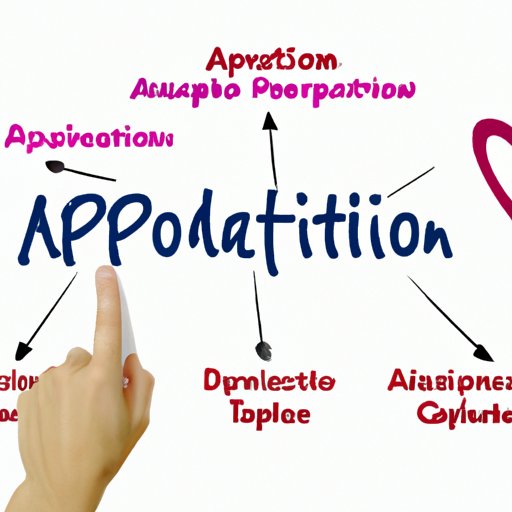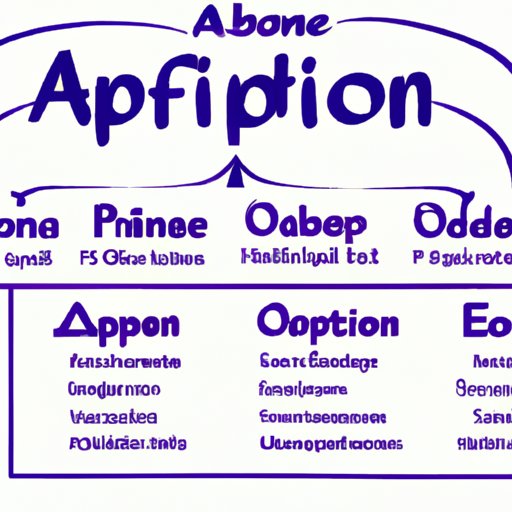Introduction
Adoption is a powerful way to create or grow a family. It’s an act of love that has a profound impact on the lives of all those involved. But how exactly does adoption work? In this article, we’ll explore the different types of adoption, the steps of the process, and the potential benefits of adoption.
Explaining the Adoption Process Step-by-Step
The adoption process can seem overwhelming at first, but understanding the steps involved can help make it less intimidating. Generally speaking, the process involves filing an adoption petition, completing a home study and background check, placing the child in the home, and finalizing the adoption.
Filing an Adoption Petition
The first step in the adoption process is filing an adoption petition with the court. This document outlines the reasons why the prospective adoptive parents are seeking to adopt and provides information about the child being adopted. Depending on the type of adoption, additional paperwork may be required.
Home Study and Background Check
Once the adoption petition is filed, a social worker will conduct a home study to assess the suitability of the adoptive parents. The study typically includes interviews with the prospective parents, a review of their financial situation, and a background check. The purpose of the study is to ensure that the adoptive parents have the resources and stability necessary to provide a safe and loving home for the child.
Placement of the Child in the Home
After the home study is completed, the child can be placed in the home of the adoptive parents. This is a joyous occasion, but it’s important to remember that it’s also a time of transition and adjustment for the child. The adoptive parents should be prepared to provide emotional support and assistance during this period.
Finalization of the Adoption
After the child has been placed in the home, the adoptive parents must complete any remaining paperwork and attend a final hearing. At the hearing, a judge will review the adoption petition and home study and make a decision regarding the adoption. If the adoption is approved, the judge will issue a final order of adoption, officially making the child a part of the adoptive family.

Examining the Different Types of Adoption
Adoptions come in many forms, and each type has its own unique set of requirements and procedures. Some of the most common types of adoption include domestic infant adoption, foster care/kinship adoption, international adoption, and stepparent adoption.
Domestic Infant Adoption
Domestic infant adoption is the most popular form of adoption in the United States. It involves matching a birth mother with prospective adoptive parents and arranging for the transfer of parental rights from the birth mother to the adoptive family. This type of adoption is highly regulated and typically requires the involvement of an experienced adoption agency.
Foster Care/Kinship Adoption
Foster care/kinship adoption involves adopting a child who is currently in the foster care system. This type of adoption is often less expensive and less time-consuming than other types of adoption, as the child is already in the adoptive family’s home. However, it can involve additional challenges, as the child may have experienced trauma or have special needs.
International Adoption
International adoption involves adopting a child from another country. This type of adoption is highly regulated and can be complicated and expensive. Prospective adoptive parents must meet the eligibility requirements for both the sending and receiving countries, and the process can take several months or even years to complete.
Stepparent Adoption
Stepparent adoption allows a stepparent to legally adopt his or her spouse’s child. This type of adoption is relatively straightforward and often involves fewer steps than other types of adoption. In most cases, the biological parent must consent to the adoption and the stepparent must pass a background check.

Discussing the Pros and Cons of Adoption
Adoption can be an incredibly rewarding experience, but it’s not without its challenges. It’s important to understand both the benefits and potential drawbacks of adoption before taking the plunge.
Benefits of Adoption
Adoption offers a number of potential benefits for adoptive parents, including:
- Building a family
- Providing a loving home for a child in need
- Receiving tax benefits and other financial incentives
- Gaining access to adoption services and support
Challenges of Adoption
Adoption also comes with some potential challenges, including:
- High costs associated with the adoption process
- Lengthy wait times for certain types of adoption
- Potential legal complications
- Emotional complexities associated with adoption

Exploring the Benefits for Children Who Are Adopted
Research shows that adoption can have a number of positive impacts on children, including improved health outcomes, increased educational opportunities, and greater emotional stability.
Improved Health Outcomes
Adopted children tend to have better health outcomes than their non-adopted peers. According to a study published in the journal Pediatrics, adopted children “experienced fewer hospitalizations, fewer visits to specialists, fewer emergency department visits, and lower overall healthcare costs compared with nonadopted children.”
Increased Educational Opportunities
Adopted children also tend to have higher educational attainment than their non-adopted peers. A study published in the journal Demography found that adopted children “were significantly more likely to attend college and earn higher levels of education than nonadopted children.”
Greater Emotional Stability
Adopted children often experience greater emotional stability than their non-adopted peers. A study published in the journal Child Development found that adopted children had “fewer behavioral problems and higher self-esteem than nonadopted children.”
Investigating Adoption Laws by State
Adoption laws vary from state to state, so it’s important to research the laws in your state before beginning the adoption process. Every state has different laws regarding who is eligible to adopt, what kind of adoption is allowed, and what steps must be taken in order to finalize the adoption.
Researching State Laws
Prospective adoptive parents should start by researching the laws in their state. The U.S. Department of Health & Human Services provides a list of state-specific adoption laws and resources on their website.
Understanding the Differences Between States
It’s also important to understand the differences between states when it comes to adoption. For example, some states allow same-sex couples to adopt while others do not. Additionally, some states require a waiting period before the adoption can be finalized, while others do not.
Addressing Common Questions About Adoption
Adoption is a complex process, and prospective adoptive parents often have a lot of questions. Here are answers to some of the most common questions about adoption.
What is Open Adoption?
Open adoption is a type of adoption in which the birth parents and adoptive parents maintain contact throughout the adoption process and beyond. This type of adoption can be beneficial for both the adoptive parents and the birth parents, as it allows them to stay connected and build a relationship.
How Much Does it Cost to Adopt a Child?
The cost of adoption varies depending on the type of adoption and the agency or attorney used. Domestic infant adoption typically costs between $20,000 and $40,000, while foster care/kinship adoption is usually much less expensive. International adoptions can cost anywhere from $30,000 to $50,000.
How Long Does the Adoption Process Take?
The length of the adoption process depends on the type of adoption and where the adoptive parents live. Domestic infant adoptions typically take between eight and twelve months, while international adoptions can take up to two years. Foster care/kinship adoptions can take anywhere from six months to several years.
Focusing on Open Adoption and Its Impact
Open adoption is becoming increasingly popular, and it can have a number of positive impacts on both the adoptive parents and the birth parents.
Definition of Open Adoption
Open adoption is a type of adoption in which the birth parents and adoptive parents maintain contact. This can include exchanging letters or emails, sharing photos and updates, and even meeting in person. Open adoption is becoming increasingly common, and it can be beneficial for both the adoptive parents and the birth parents.
Benefits of Open Adoption
Open adoption offers a number of potential benefits, including:
- Providing the birth parents with peace of mind
- Allowing the adoptive parents to gain insight into the child’s background and medical history
- Giving the adoptive parents the opportunity to build relationships with the birth parents
- Creating a sense of continuity for the child
Potential Challenges of Open Adoption
While open adoption can be beneficial, it also has the potential to be challenging. It’s important to discuss expectations and boundaries with the birth parents to ensure that everyone is comfortable with the level of contact.
Conclusion
Adoption is an incredibly rewarding experience for both the adoptive parents and the child. By understanding the different types of adoption, the steps of the process, and the potential benefits of adoption, prospective adoptive parents can make an informed decision about whether or not to pursue adoption.
(Note: Is this article not meeting your expectations? Do you have knowledge or insights to share? Unlock new opportunities and expand your reach by joining our authors team. Click Registration to join us and share your expertise with our readers.)
